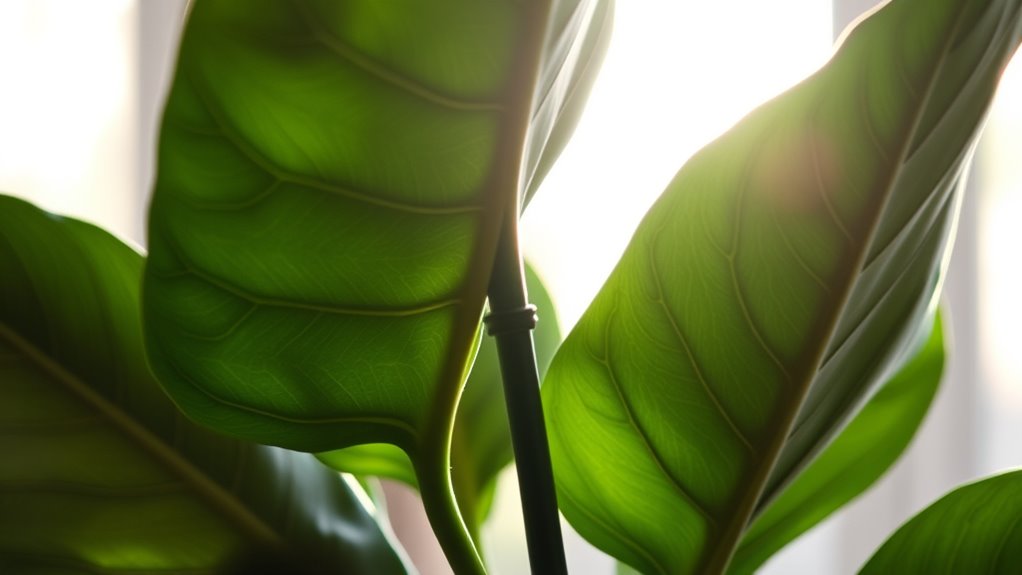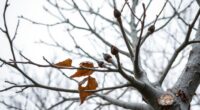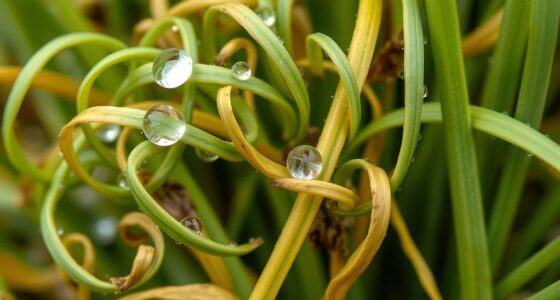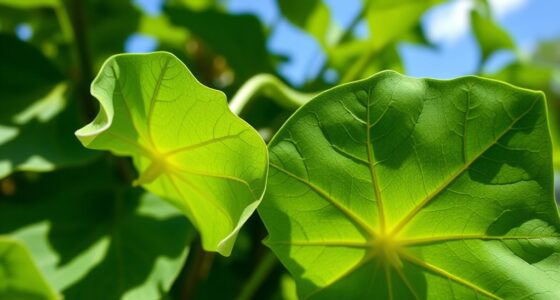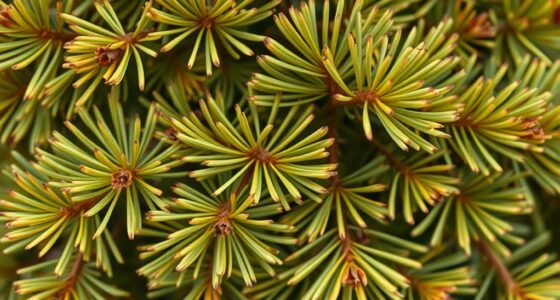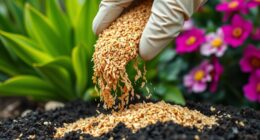If your fiddle leaf fig’s leaves are leaning, it’s likely due to uneven light or lack of support. Adjust the light direction so it’s evenly distributed around the plant, and rotate it regularly to prevent asymmetry. Using a stake can help support leaning stems, especially for taller plants. Proper staking techniques and balanced lighting will keep your fig upright and healthy. Keep going to learn more tips for strong, upright growth.
Key Takeaways
- Leaning leaves often indicate uneven light exposure; rotate your plant regularly for balanced illumination.
- Use stakes or supports early to guide upright growth and prevent leaning caused by weak stems.
- Adjust light sources to ensure even distribution, avoiding excessive leaning toward a single light source.
- Gently tie leaning stems to stakes using soft ties to provide stability without damaging the plant.
- Prune leggy or leaning branches to promote symmetrical growth and reduce strain on unsupported stems.
Understanding Why Fiddle Leaf Fig Leaves Lean
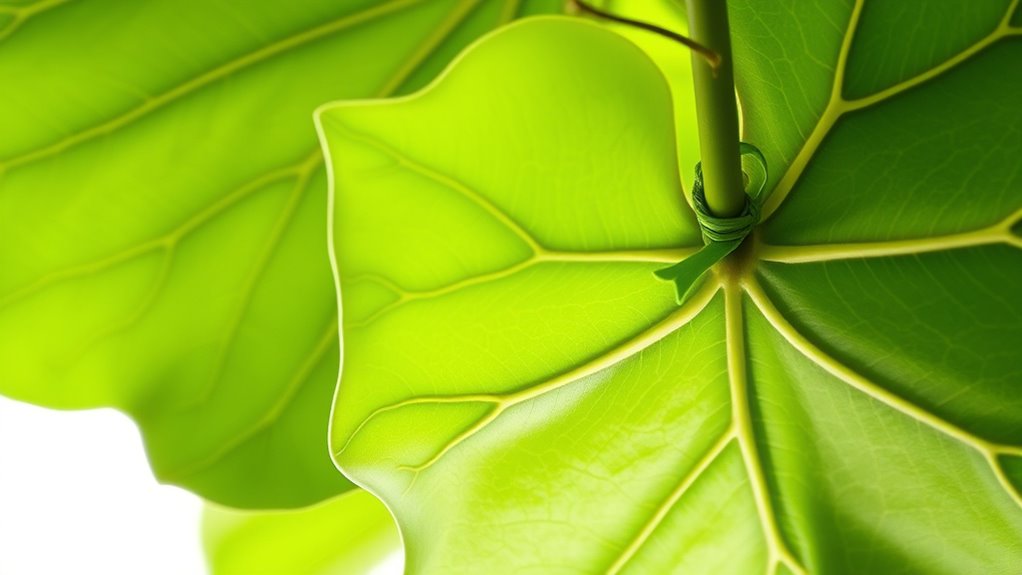
Fiddle leaf fig leaves often lean when the plant isn’t receiving the right conditions or care. One common reason is poor root health, which can cause instability and uneven leaf growth. If the roots are too dry or overly saturated, they can’t support the plant properly, leading to leaning leaves. Your watering frequency plays an essential role here—water too often, and you risk root rot; water too little, and roots dry out. Ensuring a balanced watering schedule helps maintain healthy roots, providing the stability needed for your plant to grow upright. Check your soil regularly, and adjust watering based on the soil’s moisture. Healthy roots translate to stronger support, reducing the tendency for leaves to lean or droop. Additionally, proper staking can aid in supporting leaning leaves until the plant regains strength, especially when combined with correct light conditions that promote even growth.
The Impact of Light Direction on Leaf Growth
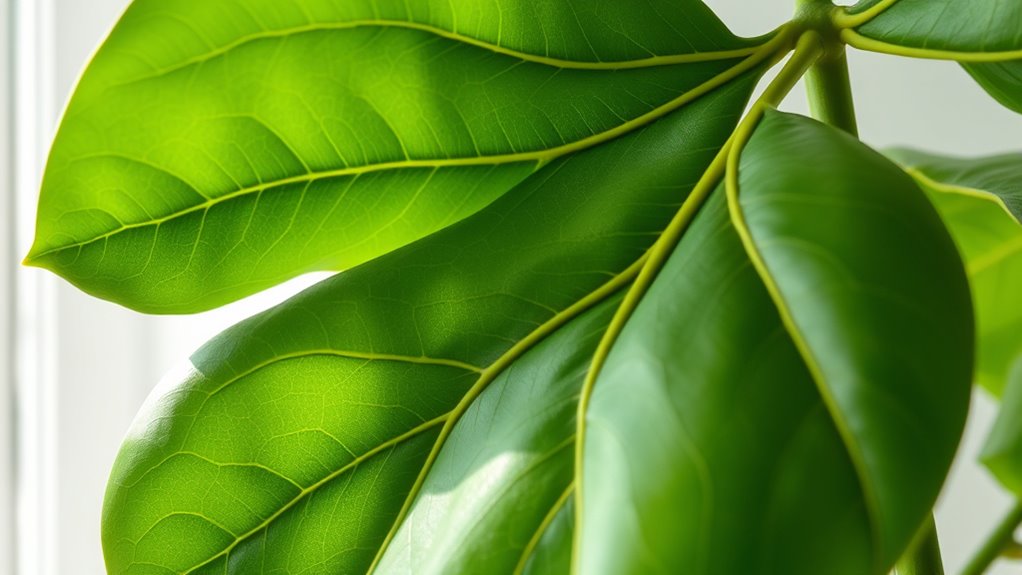
The way you position the light source directly influences how your fiddle leaf fig’s leaves grow. When light comes from one side, expect the leaves to orient and lean toward that direction. This variation in light can also alter the plant’s overall growth pattern over time. To support healthy growth and prevent leaning, consider using multi-functional furniture or stake support, which can help guide the plant’s direction and maintain its upright posture. Additionally, understanding plant physiology can help you create a more balanced environment for your fiddle leaf fig.
Light Source Positioning
When light isn’t positioned correctly, the leaves of your fiddle leaf fig may lean toward the source, seeking better illumination. To prevent this, guarantee your plant receives evenly distributed light by adjusting the light source’s position regularly. Proper light placement encourages balanced growth and reduces leaning. Remember, pruning techniques can help shape your plant and promote healthy, upright growth. Also, maintaining consistent watering schedules supports overall plant health, making it more resilient to light fluctuations. Avoid overexposing or underlighting your fiddle leaf fig, as uneven light can cause uneven growth and leaning. Providing optimal light conditions helps your plant grow straight and strong, reducing the need for stake support or corrective pruning later. Incorporating sound therapy techniques can also promote overall plant health and resilience to environmental stressors. Ensuring your plant receives proper light distribution can further minimize leaning and promote symmetrical growth.
Leaf Orientation Changes
Light direction plays a crucial role in how your fiddle leaf fig’s leaves grow and orient themselves. When light shifts, you’ll notice changes in leaf orientation, as the plant adapts its growth patterns to maximize exposure. Leaves tend to turn toward the light source, creating a dynamic display of growth. This adjustment helps the plant optimize photosynthesis and maintain healthy development. To visualize this, consider the following:
| Light Direction | Leaf Orientation Effect |
|---|---|
| From the side | Leaves lean toward the light |
| Overhead | Leaves grow vertically downward |
| Low light | Leaves stretch upward to find light |
| Uneven light | Some leaves favor one side |
Understanding these growth patterns helps you position your plant effectively for balanced growth. Recognizing how light direction influences plant growth can assist in creating an ideal environment for your fiddle leaf fig. Additionally, observing leaf orientation changes can provide insights into whether your plant is receiving adequate light. Being aware of plant adaptation mechanisms can help you better manage your plant’s health and growth needs.
Growth Pattern Variations
Different light directions cause noticeable variations in how your fiddle leaf fig’s leaves grow and arrange themselves. When light comes from the side, leaves tend to lean toward the source, creating asymmetrical growth. If you want uniform growth, you might need to adjust your pruning techniques to encourage balanced branching. Proper soil moisture also plays a role, as overwatering or underwatering can stress the plant, affecting leaf development. Consistent watering helps maintain healthy growth patterns, regardless of light direction. Additionally, rotating your plant regularly can prevent leaning and promote even leaf distribution. By understanding how light influences growth, you can tailor pruning techniques and soil care to foster a more symmetrical, vibrant fiddle leaf fig. Using appropriate support methods like stakes can also help guide the growth and prevent leaning. Regularly monitoring your plant’s health can help you spot early signs of stress and adjust your care routine accordingly. Incorporating self-watering plant pots can also assist in maintaining consistent soil moisture, which is essential for preventing stress-related leaf issues.
Recognizing Signs of Insufficient or Uneven Lighting

If your fiddle leaf fig’s leaves are leaning or drooping, it could be a sign that its lighting isn’t adequate or is uneven. Insufficient light causes leaves to stretch toward the light source or droop due to weak growth. You might notice uneven leaf coloration or slowed growth, which also relate to soil composition and watering schedule. To better understand the signs, review this table:
| Sign | What It Means |
|---|---|
| Leaning away from light | Insufficient direct light |
| Drooping leaves | Poor soil drainage or overwatering |
| Uneven leaf color | Unequal light distribution |
| Stunted growth | Low light levels or inconsistent watering |
Adjust lighting and review your watering schedule to promote balanced growth. Proper lighting is essential for the health of your plant, and understanding light requirements can help prevent these issues. Additionally, ensuring your plant receives the correct indoor light conditions can significantly improve its overall health and appearance. Recognizing the importance of adequate light can lead to healthier, more vibrant foliage.
How to Adjust Light for Balanced Growth
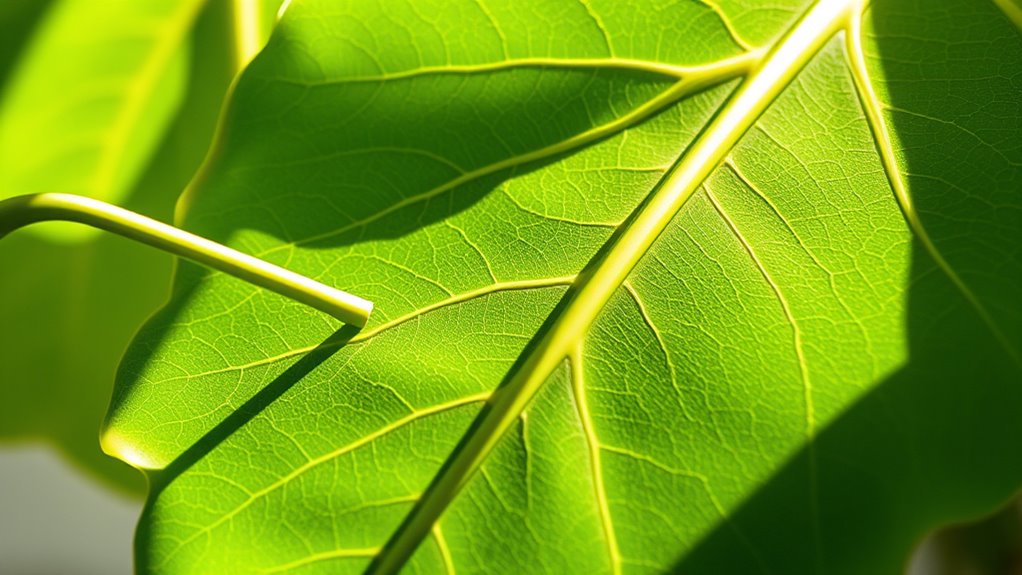
To promote balanced growth, start by rotating your plant regularly so all sides receive even light. If natural sunlight is limited, consider adding artificial lighting to supplement it. Adjust nearby windows or light sources to guarantee your fiddle leaf fig gets consistent, well-distributed illumination. Using a light directional approach can help prevent leaning and encourage uniform development. Additionally, monitoring light exposure over time ensures your plant continues to receive optimal light for healthy growth.
Rotate for Even Light
Rotating your fiddle leaf fig regularly guarantees all sides receive equal exposure to light, promoting balanced growth. This simple step prevents leaning leaves and uneven development. As you rotate, consider the plant’s soil nutrients; healthy roots support steady growth, so make certain you’re fertilizing appropriately. If you notice uneven leaf size or shape, pruning techniques can help redirect energy to underdeveloped areas. By trimming leggy or leaning stems, you encourage the plant to grow more evenly. Regular rotation also allows you to spot any issues early, such as pests or disease. Proper lighting conditions are essential for healthy growth, and adjusting light direction can further improve symmetry. Incorporating these practices ensures your fiddle leaf fig develops symmetrically, with lush foliage. Consistent rotation, combined with proper soil care and pruning, keeps your plant healthy and upright. Additionally, understanding light direction helps optimize growth and prevent leaning.
Use Artificial Lighting
Adjusting artificial lighting is essential when natural light isn’t sufficient or uneven, ensuring your fiddle leaf fig receives consistent illumination. Proper lighting promotes healthy growth and prevents leaves from leaning. To optimize your setup, consider these tips:
- Use grow lights that mimic natural sunlight, positioned about 12–18 inches above the plant.
- Maintain a regular watering schedule to support soil nutrients, which work together with light for healthy growth.
- Adjust light duration—aim for 12-16 hours daily if natural light is limited.
- Avoid sudden changes in light intensity, which can stress your plant.
Consistent lighting helps prevent leaf leaning caused by uneven growth. Combining proper artificial light with balanced watering and soil nutrients will keep your fiddle leaf fig thriving.
Adjust Natural Light Sources
Since natural light can vary throughout the day and across different seasons, you need to actively manage its sources to promote balanced development in your fiddle leaf fig. Position your plant near a south-facing window for ideal illumination, and rotate it weekly to ensure even exposure. If sunlight is too strong, use sheer curtains to diffuse the light, preventing leaf scorch and promoting healthy plant nutrition. Adjusting light also helps reduce stress that can weaken your plant’s defenses against pests. Be mindful of shadows cast by furniture or other plants, which can cause uneven growth. Proper light management encourages even foliage development, improves plant nutrition, and minimizes pest issues caused by stressed, weak leaves. Regularly monitor and tweak your setup for consistent, balanced growth.
When and How to Use Stake Supports for Stability

When your fiddle leaf fig’s leaves start leaning or sagging, it’s a clear sign that the plant needs additional support to stay upright. Use stake supports when the plant’s growth becomes top-heavy or after root pruning, which can weaken stability. To guarantee proper use:
- Insert stakes early in the growing season to guide growth.
- Tie the main stem gently to the stake with soft ties, avoiding damage.
- Check regularly for signs of stress, adjusting ties as needed.
- Ensure the plant’s fertilizer needs are met, promoting strong, healthy growth that supports stability.
Using stakes helps prevent leaning, especially during periods of rapid growth or when root pruning temporarily weakens the root system. Proper support encourages upright growth and reduces stress on the plant’s structure.
Selecting the Right Stake Materials and Sizes
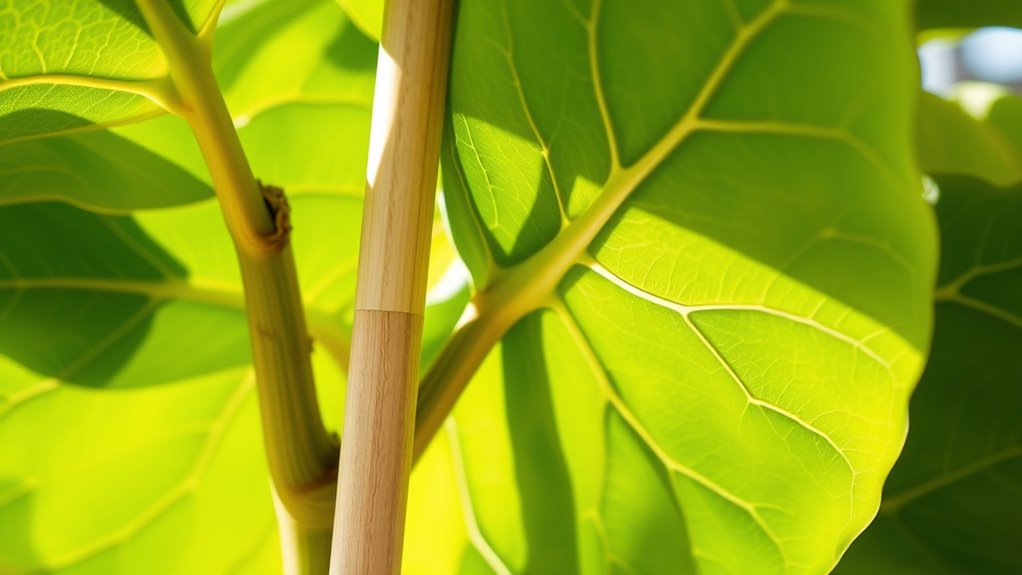
Choosing the right stake materials and sizes is essential to providing stable support without damaging your fiddle leaf fig. You want a stake sturdy enough to hold the plant’s weight but gentle enough not to harm the trunk. Wooden stakes are popular because they’re natural and flexible, but metal or bamboo can work too. Make sure the stake is thick enough to support your plant’s size—typically ½ to 1 inch in diameter. Proper staking also helps maintain a healthy watering schedule by preventing leaning, which can affect soil nutrients absorption. When selecting a stake, consider your plant’s growth rate and overall health, ensuring it’s tall enough to support new growth without overpowering the plant’s root system. Proper support promotes healthy development and keeps your fiddle leaf fig thriving.
Proper Techniques for Attaching Your Fiddle Leaf Fig to a Stake

To properly attach your fiddle leaf fig to a stake, you need to choose the right materials that won’t harm the plant. Use flexible ties that hold the stem securely without constricting or damaging the leaves. Make sure your ties are snug but gentle, providing stability while allowing growth.
Selecting Appropriate Stake Materials
Selecting the right stake material is essential for securely supporting your Fiddle Leaf Fig without damaging its delicate branches. The stakes should be sturdy yet gentle enough to avoid harming the plant’s roots or leaves. Consider materials that won’t rust or degrade quickly, especially if your watering schedule increases humidity or affects soil fertility. Here are four options:
- Bamboo – lightweight, flexible, and natural.
- Copper – durable and resistant to corrosion.
- Plastic-coated wire – gentle on stems and adjustable.
- Wooden dowels – sturdy and eco-friendly.
Choose a material that provides enough support without constricting growth. Proper staking not only stabilizes the plant but also promotes healthier foliage, especially when soil fertility varies and influences overall plant strength.
Attaching Without Damaging Leaves
Attaching your Fiddle Leaf Fig to a stake requires careful technique to prevent damage to its delicate leaves and stems. Use soft ties like fabric strips or plant-friendly velcro to gently secure the main stem. Avoid wrapping ties too tightly, as this can cause stress or injury to the plant. When attaching, ensure the ties don’t interfere with new growth or interfere with fertilizer application, which supports healthy development. Regularly check for pests, as proper staking can reduce stress points where pests might settle. Be gentle during attachment, and adjust ties as the plant grows to prevent constriction. Properly securing your Fiddle Leaf Fig ensures stability without harming its leaves, helping it grow upright and healthy while minimizing the risk of pest issues.
Ensuring Secure, Flexible Ties
Ensuring your ties are secure yet flexible is essential for supporting your Fiddle Leaf Fig without causing damage. Proper attachment prevents leaning and encourages healthy growth. Here are key techniques:
- Use soft plant ties or garden twine that won’t cut into the stems.
- Wrap ties loosely around the stem, avoiding tight constrictions that could hinder plant pruning or affect soil nutrition.
- Attach ties to the stake at multiple points for stability without restricting movement or growth.
- Check regularly to adjust ties as your plant grows and to prevent damage from constriction.
Always remember that supporting your plant’s structure isn’t just about tying; it also involves maintaining overall plant health through proper pruning and soil nutrition. This ensures your Fiddle Leaf Fig stays strong and vibrant.
Combining Light Adjustment and Support for Optimal Health
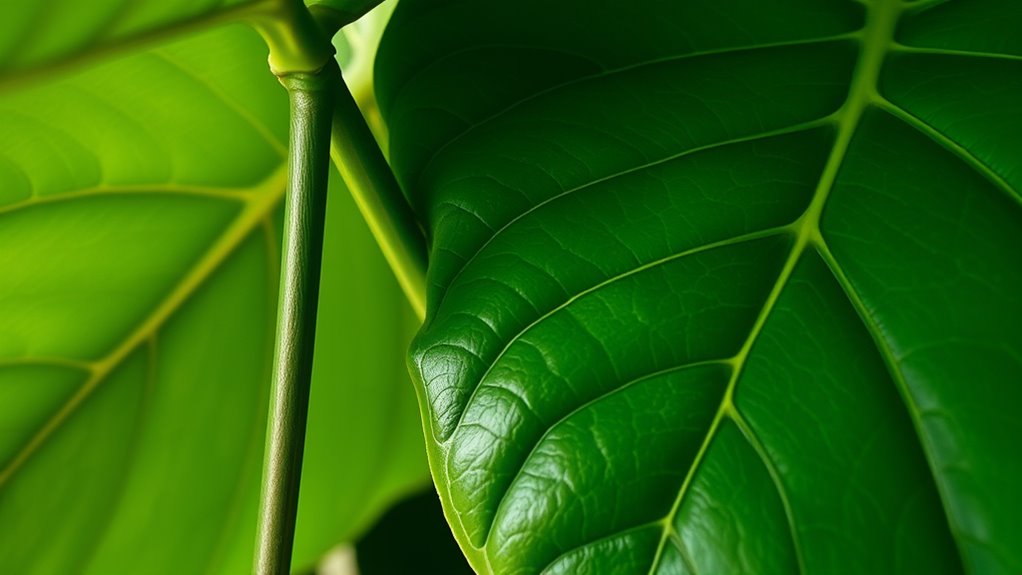
Have you noticed your fiddle leaf fig’s leaves leaning or reaching toward a light source? To promote healthy growth, combine light adjustments with proper support. Position your plant near a bright, consistent light source, rotating it regularly to encourage even development. Use pruning techniques to remove damaged or overly leaning leaves, encouraging a balanced shape. Ensure watering practices are consistent; overwatering can weaken stems, causing leaning, while underwatering stresses the plant. Supporting the plant with stakes can help maintain upright growth as it adjusts to the new light. Consider the following table to understand key support strategies:
| Light Adjustment | Pruning Techniques | Watering Practices |
|---|---|---|
| Rotate weekly for even growth | Remove damaged leaves | Water when topsoil dries |
| Use grow lights if needed | Trim leggy stems | Avoid overwatering |
| Ensure consistent light source | Thin overgrown branches | Maintain proper drainage |
| Adjust light intensity as needed | Shape for balance | Water deeply, then dry |
| Keep light indirect if too intense | Encourage bushiness | Maintain moisture levels |
Preventing Future Leaning and Growth Issues
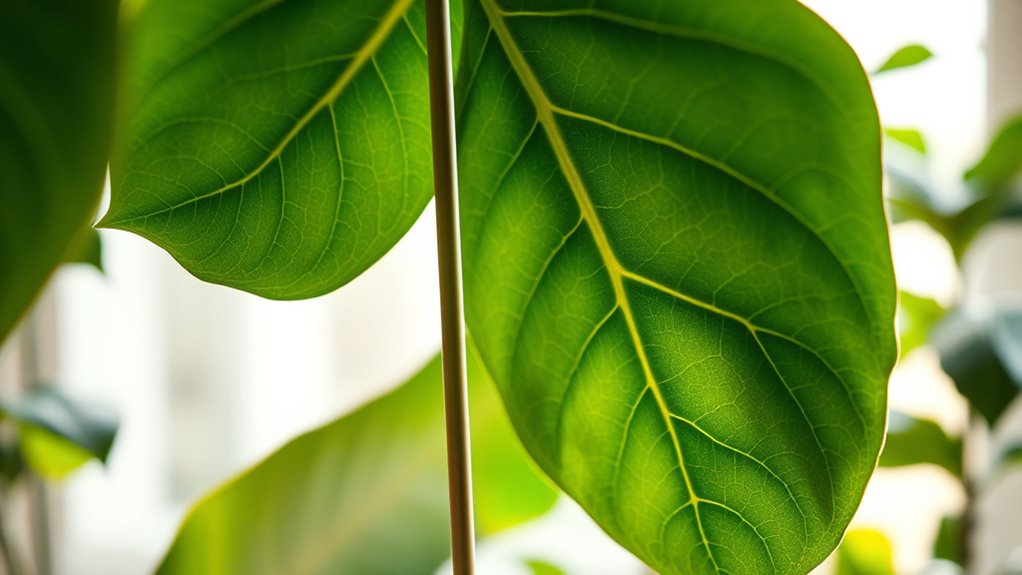
To prevent future leaning and growth issues, establishing consistent care routines and monitoring your plant’s development regularly is essential. Proper pruning techniques help maintain an upright shape and remove weak or damaged leaves that can cause imbalance. Keep soil moisture steady; avoid overwatering or letting it dry out completely, as inconsistent hydration can weaken roots and affect growth. Here are four tips:
Consistent care, proper pruning, steady watering, and support help your plant stay upright and healthy.
- Regularly check soil moisture levels to ensure proper watering.
- Use pruning techniques to remove leaning or spindly growth.
- Rotate your fiddle leaf fig periodically to promote even light exposure.
- Support new growth with stakes or ties until it strengthens.
Implementing these practices helps your plant grow strong and upright, reducing future leaning problems.
Tips for Maintaining a Strong and Upright Fiddle Leaf Fig

Maintaining a strong and upright fiddle leaf fig requires consistent attention to its growth habits. Regular pruning techniques help remove weak or leaning branches, encouraging a balanced shape. Guarantee you follow proper watering schedules: water when the top inch of soil feels dry to prevent overwatering or drought stress. Proper light exposure also supports healthy growth; place your plant where it gets bright, indirect sunlight. Use stakes if needed to support leaning stems, especially during active growth. Monitor your plant regularly for signs of weakness or uneven growth. Keep an eye on soil moisture and prune to promote vertical growth.
| Pruning Techniques | Watering Schedules | Support Tips |
|---|---|---|
| Remove dead leaves | Water weekly | Use stakes for leaning stems |
| Trim weak stems | Adjust based on season | Tie stems gently |
| Shape for balance | Avoid overwatering | Ensure proper light |
Frequently Asked Questions
How Often Should I Rotate My Fiddle Leaf Fig for Even Growth?
To guarantee even growth, you should rotate your fiddle leaf fig about once a week. This helps all sides receive equal light, preventing leaning and uneven development. Keep in mind your watering schedule and soil drainage, as these affect overall health. Adjust watering based on soil moisture, and ensure proper drainage to avoid root issues. Regular rotation combined with proper watering keeps your plant balanced and thriving.
Can Changing Light Direction Harm My Fiddle Leaf Fig?
Thinking about changing your fiddle leaf fig’s light direction? It’s a smart move, but do it gradually to prevent plant stress. Sudden light adjustment can shock your plant, causing leaf drop or leaf leaning. Slowly shifting the light source allows your fiddle leaf fig to adapt comfortably, avoiding harm. Remember, consistent care cultivates a healthy, thriving plant, so gentle changes are key to keeping your fiddle leaf fig flourishing.
What Are the Best Stake Materials for Tall, Mature Plants?
For tall, mature plants, choosing the right stake material options is key for effective support. You should consider sturdy options like bamboo, metal, or real wood, which provide reliable tall plant support without damaging the plant. Bamboo is lightweight and natural, while metal offers durability. Select a stake that’s strong enough to hold the plant upright, and secure it gently to avoid harming the stems.
How Do I Know if My Stake Is Too Tight or Too Loose?
Think of your stake like a gentle handshake with your plant; too tight, and you risk strangling its growth, too loose, and it’ll sway like a ship on rough seas. Check the stake tension by lightly tugging—if there’s no give, it’s too tight. For support stability, make sure the stake holds the stem securely but allows natural movement. Adjust as needed to keep your plant supported without constraining it.
Should I Prune My Fiddle Leaf Fig to Prevent Leaning?
You might consider pruning your fiddle leaf fig if it’s leaning considerably, as it promotes plant health and stability. Using proper pruning techniques, like removing dead or overgrown leaves, encourages balanced growth and prevents further leaning. Pruning helps maintain the plant’s overall structure, ensuring it stays healthy and upright. Always prune gently and avoid cutting too much at once, supporting your plant’s growth and preventing future issues.
Conclusion
By tuning into your fiddle leaf fig’s light and giving it gentle support, you’re guiding it to stand tall like a proud, leafy monument. Just as a gardener tends to a delicate vine, your attentive care helps your plant reach for the sun with confidence. Keep a close eye, adjust your approach as needed, and watch your fig flourish into a lush, vibrant masterpiece that’s as resilient as it is beautiful.
